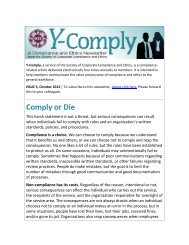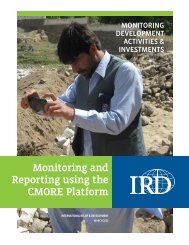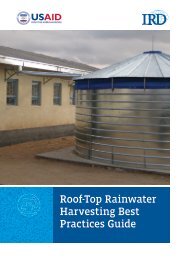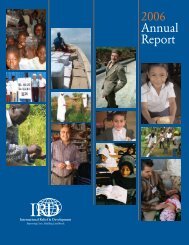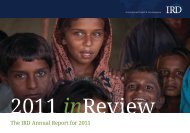Empowering citizens Engaging governments Rebuilding communities
Empowering citizens Engaging governments Rebuilding communities
Empowering citizens Engaging governments Rebuilding communities
You also want an ePaper? Increase the reach of your titles
YUMPU automatically turns print PDFs into web optimized ePapers that Google loves.
CSP helped create a sense of normalcy<br />
among those who participated and<br />
across the population at large<br />
3<br />
Box 6<br />
CSP: Results<br />
Successes and setbacks<br />
CSP had two overarching goals: increasing employment and mitigating conflict. CSP directly benefited Iraqi <strong>communities</strong><br />
in areas most “at risk” by creating jobs, helping families generate income, rebuilding infrastructure, and<br />
implementing youth programs. The program helped create a sense of normalcy among those who participated and<br />
across the population at large. At its conclusion, CSP had:<br />
• Generated more than 525,000 short-term jobs—120 percent of program targets. CSP exceeded its targets for<br />
short-term person-months of employment each year of operation.<br />
• Created or restored more than 57,100 long-term jobs—134 percent of program targets.<br />
• Completed more than 1,600 total projects that rebuilt, refurbished, or revitalized key pieces of community<br />
infrastructure.<br />
• Created or expanded more than 10,000 businesses through micro, small, and medium enterprise grants and other<br />
program interventions.<br />
• Provided business development and skills training to more than 15,000 entrepreneurs.<br />
• Graduated 41,443 <strong>citizens</strong> from vocational training programs developed in collaboration with the Ministry of Labor<br />
and Social Affairs and covering a wide variety of marketable skills, including carpentry, construction, sewing, and<br />
electrical repair. The graduated number of trainees represented 112 percent of program targets.<br />
• Placed more than 9,900 vocational skills trainees in apprenticeships, where they continued to gain valuable job<br />
training. Almost 20 percent of the apprentice placements went to women.<br />
• Engaged more than 350,000 at-risk Iraqis ages 17–35 in more than 500 youth participation activities, including<br />
team sports competition and arts training. The number of Iraqi youth taking part in CSP-sponsored events<br />
exceeded targets by 43 percent.<br />
business grants and skills training and jobs created<br />
in direct support of the COIN strategy. With CSP, each<br />
served completely different purposes. Long-term<br />
employment primarily supported the business community<br />
and the more skilled type of laborer who was<br />
unemployed as a direct result of the war—like a shop<br />
owner whose business was destroyed and employees<br />
put out of work. Getting these Iraqis back to work supported<br />
medium- and long-range COIN objectives.<br />
Short-term employment, by contrast, proved effective<br />
in supporting the immediate COIN objectives<br />
crucial to the clear-hold-build strategy. This type of<br />
employment targeted unskilled or semiskilled laborers<br />
who would otherwise be open to recruitment into<br />
the insurgency. It also injected much-needed capital<br />
back into war-torn <strong>communities</strong> and helped rebuild a<br />
sense of community. “If your city has been shot up,<br />
and somebody is at least sweeping up the rubble<br />
in the marketplace, it doesn’t guarantee that life is<br />
going to be rosy, but it gives you some fragment of<br />
hope in a situation that’s otherwise pretty hopeless,”<br />
said James Kunder, an IRD advisor and former acting<br />
administrator of USAID. A cash-for-work jobs program,<br />
which was the central tenet of the CIES component,<br />
“doesn’t eliminate the placement of IEDs and things<br />
like that,” Kunder said, “but it gives people something<br />
productive to do other than plant IEDs, and it also<br />
gives some sense of hope for the future.”<br />
“A rapid, highly visible, and tangible impact”<br />
The CIES program component was divided into two<br />
general project areas—infrastructure rehabilitation<br />
36


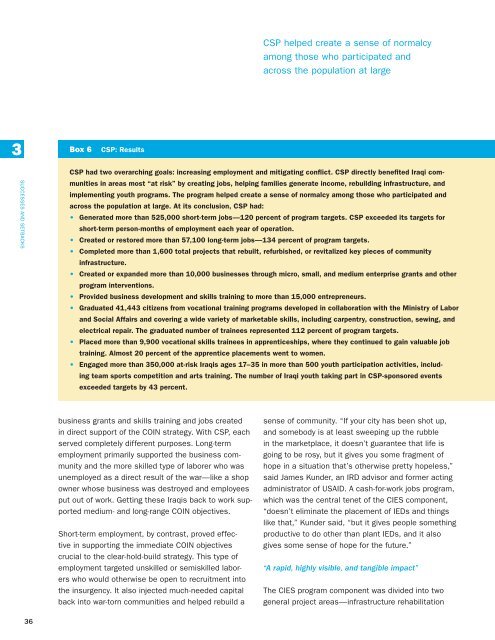
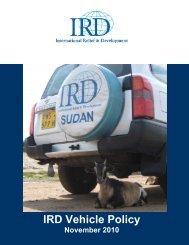
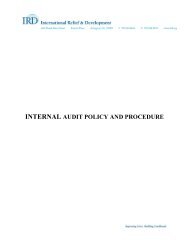
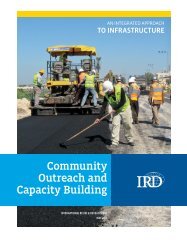
![Guide bonne pratique production d'oignon qualité_VF_4_2411012[1]](https://img.yumpu.com/23506639/1/184x260/guide-bonne-pratique-production-doignon-qualitac-vf-4-24110121.jpg?quality=85)

